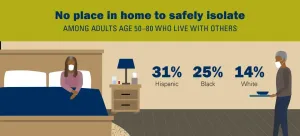(Press-News.org) One of the most important ways to stop the spread of COVID-19 is for people who have tested positive, or have symptoms, to isolate themselves from the other people they live with.
But a new University of Michigan poll suggests that nearly one in five older adults don't have the ability to do this - and that those who are Hispanic or Black, or who have lower incomes or poor health to begin with, are more likely to lack a safe isolation place in their home.
The poll also shows significant inequality in another key aspect of staying safe and healthy during the pandemic: the ability to get outside for fresh air and exercise, and to engage safely with friends, neighbors and relatives in open air.
Older adults who had more access to outdoor spaces around their home, and those who could walk to greenspaces like parks, gardens or woods, were more likely to engage in the kinds of outdoor activities and safe social connections that experts urge everyone to engage in during the pandemic. But that access also varied by income, race/ethnicity and health status.
The poll shows how important the 'built environment' of housing and local outdoor public spaces is to the health of older adults, says the team that conducted the poll as part of the National Poll on Healthy Aging, based at U-M's Institute for Healthcare Policy and Innovation.
The poll receives support from AARP and Michigan Medicine, U-M's academic medical center, and draws from the answers of a national sample of more than 2,000 adults aged 50 to 80.
"These findings build on what we already know about the link between a person's home and community environment, and their engagement in health-promoting activities, but through the lens of a pandemic that disproportionately affects older adults, adults of color and low-income people," says Upali Nanda, Ph.D., an associate professor in U-M's Taubman College of Architecture & Urban Planning.
"In the short term, recommendations by health officials and health care providers should take these disparities into account," says Andrew Ibrahim, M.D., M.Sc., a surgeon and health care researcher at Michigan Medicine. "In the long term, architects and urban planners should see the lessons from this report as evidence that they can and should be front-line workers for the health of communities."
More about the poll findings
The ability to isolate from others in the same living space when sick with COVID-19, or known to be infected with the novel coronavirus, is critical to preventing others from getting sick. This is especially important for people who live with others who are at higher risk if they develop COVID-19, such as people over 50, people with underlying conditions such as obesity, diabetes and lung disease, and people who have weakened immune systems.
The Centers for Disease Control and Prevention recommends that people with the disease or a positive COVID-19 test result should isolate in a separate room, and use a separate bathroom if possible. The people who live with them should take other precautions to protect themselves.
"Research has proven that COVID-19 can spread easily within homes, so that's why it's concerning that 18% of people over 50 don't have a way to do so, and that this rose to 27% among those who say they're in fair or poor health, which may indicate a higher risk of severe COVID-19," says Preeti Malani, M.D., the poll director and a Michigan Medicine physician specializing in geriatrics and infectious diseases. "The disparities we saw in the poll suggest differences in living arrangements may be playing a larger role in the pandemic than we thought, and point to a need for health providers and public health officials to advise the public on ways to stay safe depending on their individual living situation."
For instance, if there's only one bedroom, the infected person should isolate there, and uninfected people should sleep on a couch or mattress in the living room. Uninfected people who live with someone with a known case of COVID-19 should also quarantine, which means staying home and not going to stores, work, school or on outings - but missing work can be hard or impossible for low-income people who work independently or in frontline hourly jobs.
Nearly a third of Hispanic poll respondents (31%) said they didn't have a place to isolate in their home, compared with 25% of Black respondents and 14% of white respondents. People with household incomes under $30,000 were more than twice as likely as those with incomes over $100,000 to say they lack a safe isolation space. Apartment dwellers were more than twice as likely as those who live in single-family detached homes to say they had no place to isolate.
On the flip side of the pandemic, living arrangements can affect older adults' ability to stay positive, healthy and socially engaged during the pandemic, the poll finds. While most of the older adults said they had an outdoor space where they could safely connect with neighbors, 32% don't live within walking distance of a greenspace.
That percentage was higher for Blacks (46%) and Hispanics (50%), and for people with incomes under $30,000 (51%). There were statistically significant differences by race/ethnicity, income, and health status in having a view of nature, place to safely connect with neighbors, and greenspace within walking distance.
"It's important that communities be livable for people of all ages, including access to work, shopping, recreation and public places," says Alison Bryant, Ph.D., senior vice president of research for AARP. "Despite the documented desire of most older adults to stay in their homes and communities as they age, research from AARP has found that most older adults do not reside in highly livable communities, and there is much more that could be done to help old adults age where they currently live."
Three-quarters of respondents said they had spent time outdoors or interacted with nature at least a few times per week in the first months of the pandemic. Nearly half had walked or bicycled around their neighborhood at least a few times a week in that time, too. Those who had access to outdoor spaces and nearby greenspaces were more likely to have done so.
INFORMATION:
In addition to their U-M faculty roles, Nanda has a role with HKS, Inc., and Ibrahim has a role with HOK, both global architecture firms.
The National Poll on Healthy Aging results are based on responses from a nationally representative sample of 2,074 adults aged 50 to 80 who answered a wide range of questions online in June 2020. Questions were written, and data interpreted and compiled, by the IHPI team. Laptops and Internet access were provided to poll respondents who did not already have them. A full report of the findings and methodology is available at http://www.healthyagingpoll.org, along with past National Poll on Healthy Aging reports.
Despite worldwide use of lithium batteries, the exact dynamics of their operation has remained elusive. X-rays have proven to be a powerful tool for peering inside of these batteries to see the changes that occur in real time.
Using the ultrabright X-rays of the Advanced Photon Source (APS), a U.S. Department of Energy (DOE) Office of Science User Facility at the DOE's Argonne National Laboratory, a research team recently observed the internal evolution of the materials inside solid-state lithium batteries as they were charged and discharged. This detailed 3D ...
The speed of light has come to 3D printing. Northwestern University engineers have developed a new method that uses light to improve 3D printing speed and precision while also, in combination with a high-precision robot arm, providing the freedom to move, rotate or dilate each layer as the structure is being built.
Most conventional 3D printing processes rely on replicating a digital design model that is sliced into layers with the layers printed and assembled upwards like a cake. The Northwestern method introduces the ability to manipulate the original design layer by layer and pivot the printing direction without recreating the model. This "on-the-fly" ...
How do the normal pains of everyday life, such as headaches and backaches, influence our ability to think? Recent studies suggest that healthy individuals in pain also show deficits in working memory, or the cognitive process of holding and manipulating information over short periods of time. Prior research suggests that pain-related impairments in working memory depend on an individual's level of emotional distress. Yet the specific brain and psychological factors underlying the role of emotional distress in contributing to this relationship are not well understood.
A new study, titled "Modeling neural and self-reported factors of affective distress in the relationship between pain and working memory in healthy individuals," and published in the journal ...
LOS ANGELES - New research from the Center for Cardiac Arrest Prevention in the Smidt Heart Institute has found for the first time that during nighttime hours, women are more likely than men to suffer sudden death due to cardiac arrest. Findings were published in the journal Heart Rhythm.
"Dying suddenly during nighttime hours is a perplexing and devastating phenomenon," said Sumeet Chugh, MD, senior author of the study and director of the Center for Cardiac Arrest Prevention. "We were surprised to discover that being female is an independent predictor of these events."
Medical experts are mystified, Chugh says, because during these late hours, most patients are in a resting state, with reduced metabolism, heart rate and blood pressure.
Sudden cardiac arrest-also called sudden cardiac ...
LOS ANGELES (Feb. 3, 2021) -- For the first time in humans, investigators at Cedars-Sinai have identified the neurons responsible for canceling planned behaviors or actions--a highly adaptive skill that when lost, can lead to unwanted movements.
Known as "stop signal neurons," these neurons are critical in powering someone to stop or abort an action they have already put in process.
"We have all had the experience of sitting at a traffic stop and starting to press the gas pedal but then realizing that the light is still red and quickly pressing the brake again," said Ueli Rutishauser, PhD, professor of Neurosurgery, Neurology and Biomedical Sciences at Cedars-Sinai and senior author of the study published ...
NEW YORK and LA JOLLA, CA--A phase 1 clinical trial testing a novel vaccine approach to prevent HIV has produced promising results, IAVI and Scripps Research announced today. The vaccine showed success in stimulating production of rare immune cells needed to start the process of generating antibodies against the fast-mutating virus; the targeted response was detected in 97 percent of participants who received the vaccine.
"This study demonstrates proof of principle for a new vaccine concept for HIV, a concept that could be applied to other pathogens, as well," says William Schief, Ph.D., a professor and immunologist at Scripps Research and executive director of vaccine design at IAVI's Neutralizing Antibody Center, whose laboratory developed the vaccine. "With our many collaborators ...
CHARLOTTE, N.C. - Feb. 3, 2021 - New research on gender inequality indicates that fewer leadership prospects in the workplace apply even to women who show the most promise early on in their academic careers.
Jill Yavorsky, an assistant professor of sociology at UNC Charlotte, co-led the study, "The Under-Utilization of Women's Talent: Academic Achievement and Future Leadership Positions," with Yue Qian, an assistant professor of sociology at the University of British Columbia.
In their paper, published in a leading social science journal, Social Forces, the social scientists discovered that men supervise more individuals ...
ROCHESTER, Minn. -- A study by Mayo Clinic researchers published in Kidney International Reports finds that immune checkpoint inhibitors, may have negative consequences in some patients, including acute kidney inflammation, known as interstitial nephritis. Immune checkpoint inhibitors are used to treat cancer by stimulating the immune system to attack cancerous cells.
"Immune checkpoint inhibitors have improved the prognosis for patients with a wide range of malignancies including melanoma, non-small cell lung cancer and renal cancer," says Sandra Herrmann, M.D., ...
URBANA, Ill. - For decades, kibble has been our go-to diet for dogs. But the dog food marketplace has exploded in recent years, with grain-free, fresh, and now human-grade offerings crowding the shelves. All commercial dog foods must meet standards for complete and balanced nutrition, so how do consumers know what to choose?
A new University of Illinois comparison study shows diets made with human-grade ingredients are not only highly palatable, they're extremely digestible. And that means less poop to scoop. Up to 66% less.
"Based on past research we've conducted I'm not surprised with the results when feeding human-grade compared to an extruded dry diet," says Kelly Swanson, the Kraft Heinz Company Endowed Professor in Human Nutrition in the ...
Like weeds sprouting from cracks in the pavement, cancer often forms in sites of tissue damage. That damage could be an infection, a physical wound, or some type of inflammation. Common examples include stomach cancer caused by H. pylori infection, Barrett's esophagus caused by acid reflux, and even smoking-induced lung cancer.
Exactly how tissue damage colludes with genetic changes to promote cancer isn't fully understood. Most of what scientists know about cancer concerns advanced stages of the disease. That's especially true for cancers such as pancreatic cancer that are usually diagnosed very late.
Researchers ...





